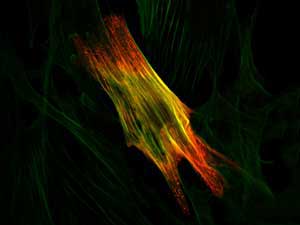| Posted: Dec 14, 2016 |
Modeling the fluorescence enhancing capabilities of materials
(Nanowerk News) The capacity of various noble metals and dielectrics to enhance fluorescence has been compared by A*STAR researchers, with a view for more sensitive technologies to create new applications in biology and medicine (Physical Chemistry Chemical Physics, "Fluorescence enhancement in visible light: dielectric or noble metal?").
|
|
Fluorescence occurs when an electron, after excitation from a fluorophore molecule, drops back from the excited state back to its ground state and emits a photon of light. Utilizing this phenomena, fluorescent labeling, a highly sensitive and non-destructive technique, allows for binding to a specific region or functional group on a target molecule, such as a protein or enzyme.
|
 |
| Fluorescent labeling is a popular technique for tracking chemical compounds in biology, medicine and forensics.
|
|
Fluorescent labeling is commonly used for tracking biological or chemical compounds in mineralogy, forensics, and medicine. Its application in DNA sequencing, molecular and cell biology, and the food safety industry is also attracting considerable interest, but relies upon light emitted by a single fluorophore, which is generally weak, thwarting its sensitivity.
|
|
This is pushing the search for technologies that amplify the fluorescence, spurring Bai Ping and colleagues from the Electronics and Photonics Department at the A*STAR Singapore Institute of High Performance Computing to compare the fluorescence enhancing capabilities of dielectric nanoparticles and silver and gold plasmonic metal nanoparticles.
|
|
“Previously, metals have been used because they are able to confine the light into a small area, producing a stronger signal,” explains Bai. “But, when the metal is placed close to the fluorophore, some of the light is re-absorbed by the metal — called quenching — reducing its fluorescence enhancing capabilities.”
|
|
As dielectric materials do not undergo quenching, particularly in the visible light range, they have also been used; but have poorer confinement capabilities compared to metals.
|
|
“A hybrid that combines the advantages of both materials is needed,” Bai says. “Our work compares the performance of both materials by taking their structures and operating environments into account, providing for an objective comparison.”
|
|
Because of the tiny distances between the materials and the fluorophores, an experimental comparison is very challenging. The researchers used a simulation based on a simple sphere nanoparticle model, and observed the fluorescence enhancement in an air and water environment. This allowed them to observe the different physical confinement characteristics for each material.
|
|
“Our results show that in air the dielectric is better, but in water the metals perform better,” says Bai. “This provided us with knowledge to explore new materials and structures that could combine the advantages of both materials, with the potential for more sensitive technologies.”
|

